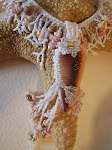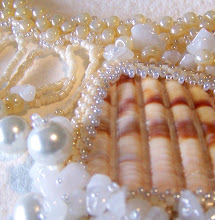Wear the coastline around your neck, the endless hues of a beach summed up in a few beachcomber beads. These are pieces that remind you of warm sea breezes, the sand under your feet, and the sun in your eyes! Each one of these is meant to take you back on vacation while you are sitting in your apartment watching the cold rain outside.
 I came up with the Seacluster completely by accident. I made a beaded spiral from a row of beads on a wire wrapped around a thin paintbrush, and gathered random shell beads and similarly hued glass beads and crystals. I got many compliments when I wore it, so I made a whole line of them. They seemed to be the only thing in my Etsy shop selling at one point! (Now it seems anything that's not Jewelry.) This is my first one:
I came up with the Seacluster completely by accident. I made a beaded spiral from a row of beads on a wire wrapped around a thin paintbrush, and gathered random shell beads and similarly hued glass beads and crystals. I got many compliments when I wore it, so I made a whole line of them. They seemed to be the only thing in my Etsy shop selling at one point! (Now it seems anything that's not Jewelry.) This is my first one:The first appearance of the word "beachcombers" in print was in Herman Melville's Omoo (1847). It described a population of Europeans who lived in South Pacific islands, "combing" the beach and nearby water for flotsam, jetsam, or anything else they could use or trade. When a beachcomber became totally dependent upon coastal fishing for his sustenance, or abandoned his original culture and set of values, then the term "beachcomber" was synonymous with a drifter, or a bum. The vast majority of beachcombers however, were simply unemployed sailors like Herman Melville in Typee, or Harry Franck in the book Vagabonding Around the World.
Many modern beachcombers follow the "drift lines" or "tide lines" on the beach and are interested in the (mostly natural) objects that the sea casts up. For these people, "beachcombing" is the recreational activity of looking for and finding various curiosities that have washed in with the tide: seashells of every kind, fossils, pottery shards, American Indian artifacts, sea beans (drift seeds), sea glass (beach glass) and driftwood. Items such as lumber, plastics, and all manner of things that have been lost or discarded by seagoing vessels will be collected by some beachcombers, as long as the items are either decorative or useful in some way to the collector. (However, this usually does not include the great bulk of marine debris, most of which is neither useful nor decorative.)
Today, many people beachcomb for beach treasures and also because the activity offers them a natural prescription to achieve better emotional, physical and spiritual health.
















